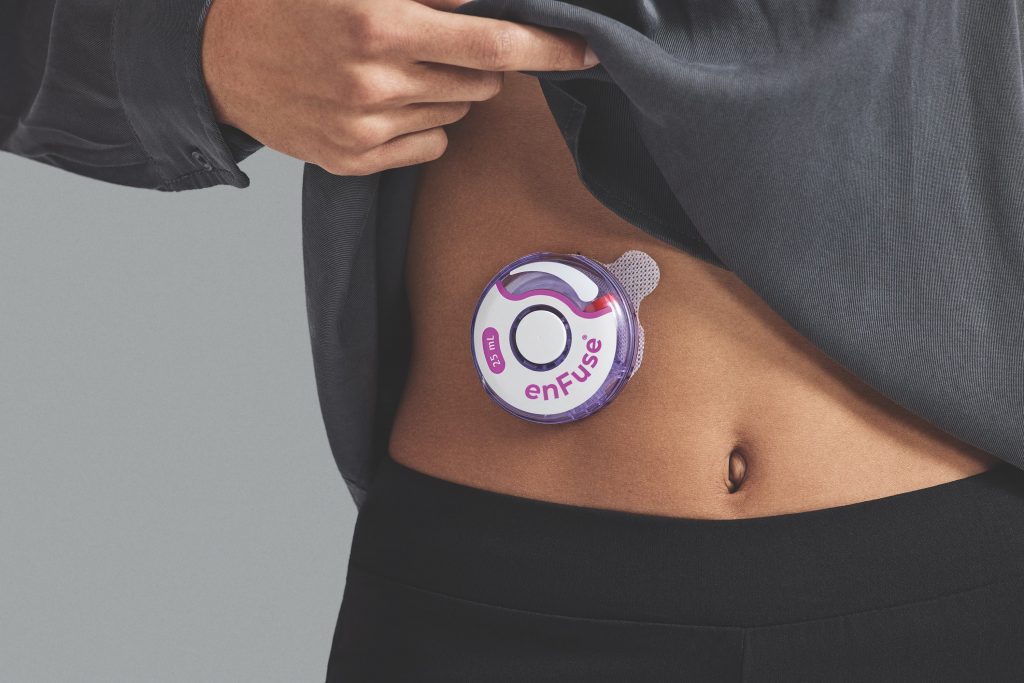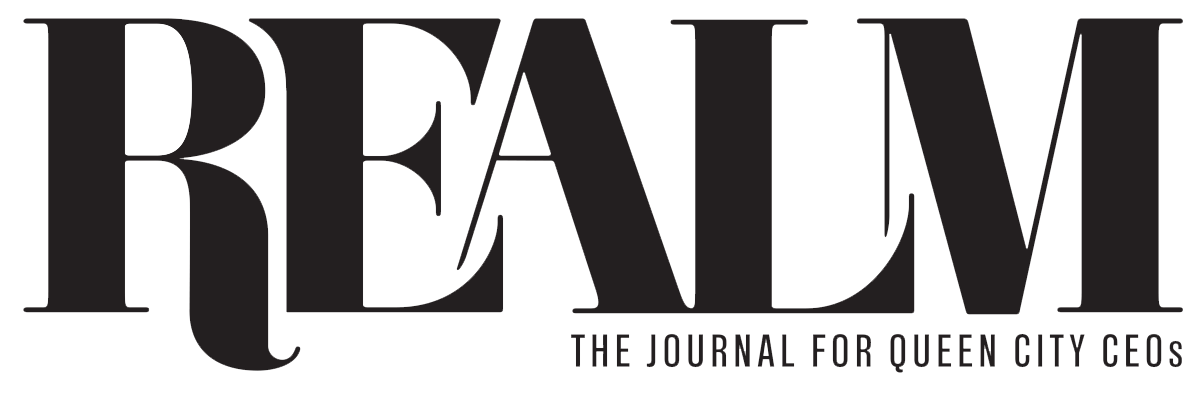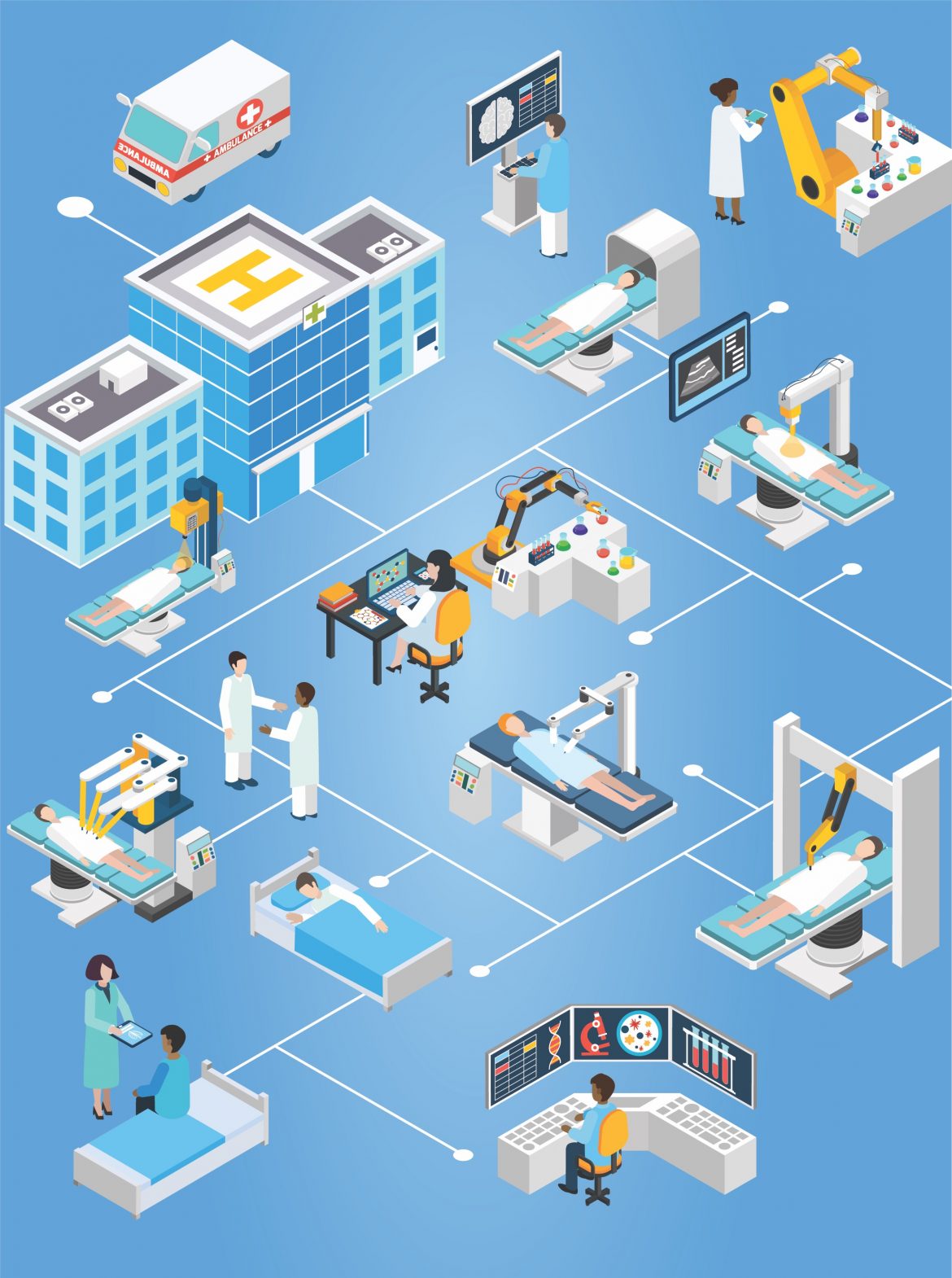When the next pandemic comes—or the next mass shooting or the next natural disaster—Cincinnati should be ready. The region’s busiest emergency medical center is undergoing a major expansion at UC Health, more than doubling in size and building in flexibility to respond to whatever the latest emergency may be. It will also house technology and expertise to assess and promptly treat the kind of challenging patients who usually wind up at UC’s emergency department.
Innovations in facility design, emergency medical technology, and medical education will be incorporated into the new emergency department, which is slated to open in two phases beginning at the end of July.
No one knows what the future will bring, and that’s just the point—the new center is being designed by physicians and nurses to adapt to whatever crises occur. “We have to be ready to take on whatever craziness comes in the next 30 years,” say Arthur Pancioli, MD, chair of UC’s Department of Emergency Medicine.
UC’s project is multi-tiered innovation on a grand scale, but cutting-edge thinking is driving the region’s health care businesses of all sizes, from the largest hospital systems to the smallest startups. Fueling these state-of-the art developments is the constantly evolving medical landscape, ranging from COVID to cardiac care, that accounts for $4 trillion total in annual spending in the U.S.
Peeyush Shrivastava is a 2013 graduate of Mason High School and a co-founder of Genetesis, a Mason-based startup that’s well down the road in developing and marketing a technology to improve the detection of cardiac disease, still the No. 1 killer of Americans. His team is adapting and refining technology that was first developed in the 1960s, when researchers discovered and recorded the heart’s biomagnetic signature. Back then, scientists developed a technique called magneto-cardiography to measure the heart’s magnetic field; by mapping it, clinicians can detect abnormalities that might be signs of arrhythmia or other heart malfunctions.

But the technology hadn’t advanced much since the ’60s, Shrivastava says, and the equipment needed to detect, measure, and record the biomagnetic fields was still big and clunky. The sensing medium was still liquid helium, an expensive and relatively scarce resource. Most machines on the market still required special rooms with magnetic shielding.
The technology was ripe for improvement, as it was being used to locate and measure magnetic fields that are tens of millions of times smaller than the earth’s own magnetic field. “Needle-in-the-haystack type measurements,” as Shrivastava says.
Around 2015, he was part of a small team that included his father and two other Mason High graduates. They began working on the technology as well as examining its potential to detect ischemia, the reduced flow of oxygen to the heart, especially when no artery blockages are known. “With improved sensing, next-generation computing, and a good team committed to meeting clinical needs that weren’t even known at the time the technology was originally conceived,” Shrivastava says, “we knew we had an opportunity to bring this technology to the forefront.”
Shrivastava and his Mason partners left college in 2016 to work on the project full-time, developing a noninvasive diagnostic machine they call Cardio-Flux. In 2019, it was cleared by the U.S. Food and Drug Administration for use as a tool to non-invasively measure and display the magnetic signals produced by the electric currents of the heart. In late 2020, CardioFlux was granted “Breakthrough Device Designation” by the FDA, a program that allows for speedier review by the government agency.
The Cleveland Clinic, as well as hospitals in North Carolina, Texas, and Michigan, have installed Genetesis systems as part of an ongoing clinical investigation. It’s also being tested at The Christ Hospital, which expects to complete its study this year.
The company has attracted venture capital, beginning with a $7.5 million round in 2018 that was led by CincyTech, Cincinnati’s public-private seed stage investment company, and included Mark Cuban of Shark Tank and Dallas Mavericks fame and the Ohio Innovation Fund, an early-stage tech investment firm. It landed an additional $9.2 million in venture funding in 2020, a round that included TDK Ventures, a Silicon Valley-based corporate VC investor.
All told, the company has earned $25 million in venture funding, Shrivastava says. “This has been our lives for almost 10 years,” he says. With Greater Cincinnati as its hometown and the participation and support from CincyTech, as well as the proximity of other tech-based health care startups, he says, “we saw this as a great place to build an exciting new business.”
Advances in treating heart disease, which kills 660,000 people in the U.S. every year, has furthered medical innovation. Doctors at The Christ Hospital, renowned for cardiac care, last year performed a new treatment to eliminate calcium in the coronary arteries. Lithotripsy, which uses sonic waves to break up calcium, has been used for years to treat kidney stones and is now available at Christ to treat certain kinds of arterial blockages.
Medical staff there also became the first in a four-state region to use a minimally invasive technique to implant an aortic valve in a procedure that did not require open-heart surgery. And UC Health cardiac surgeons last summer replaced or repaired three heart valves in a 63-year-old woman using endoscopic surgery, the least invasive surgical procedure possible.
Plenty of new businesses have been launched and supported by an engine of health care innovation here, Cincinnati Children’s Hospital Medical Center. Children’s employs more than 1,000 faculty members, about 300 of whom are PhD-level researchers with the rest as clinical faculty, typically doctors and nurses. It enjoys a legacy of pioneering medical research, most notably that of Albert B. Sabin, an immigrant from Poland who, while at Children’s in the 1940s and ’50s, developed a vaccine that helped rid the world of the fearsome disease of polio.
Children’s researchers also developed a vaccine to prevent rotavirus, a disease that causes 450,000 deaths worldwide, and conducted the first successful bone marrow transplant to treat sickle cell disease, as well as other firsts.
The legacy of groundbreaking research and commercialization goes way back at Children’s, and today the medical center employs a staff of 20 in its Innovation Ventures office to work with a portfolio of young businesses and get new technologies into the commercial marketplace. “Research and innovation go hand in hand,” says Abram Gordon, who leads the Innovation Ventures team. “Children’s has had a culture of research and innovation almost from its beginning.”
The role of Innovation Ventures is to help move promising research out of the laboratory and into commercial use, and they do that through patents, funding, creating startups, and licensing new technologies. “It’s not enough to do research and have it published and speak about it at a conference,” Gordon says. “That doesn’t get it to the patients. To get from the bench to the bedside, we need to commercialize it and license it in order to make it available to all who need it.”

Children’s partners with universities—including UC, Ben Gurion University in Israel, Oakland University, and others—as well as with early stage seed funds such as CincyTech and funds on both coasts. It has licensed technology developed at Children’s to outside companies to be further commercialized and brought to use at hospitals, doctor’s offices, and homes. One of those is Enable Injections, based in Evendale, which is marketing a wearable drug delivery system called enFuse, designed to be an alternative to intravenous administration of maintenance drugs.
In January, Enable announced that it received $215 million in financing. It’s also received funding from Children’s, CincyTech, Cincinnati-based startup accelerator Cintrifuse, and the Ohio Innovation Fund. Enable has raised more than $300 million in venture financing, making it one of the region’s best-funded startups.
Other startups have been spun off from work that was begun at Children’s. Bexion Pharmaceuticals, for instance, is moving forward with FDA-approved clinical trials of a new drug, BXQ-350, that’s shown promise in treating brain and colorectal tumors. Bexion was founded in 2006 by Ray Takigiku, MD. Now headquartered in Covington, its work is based on a technology platform licensed from Children’s. Since then, it has received more than $100 million in venture financing as well as grants from the National Cancer Institute.
Better cancer treatment is also the reason behind the work of Kurome Therapeutics, whose team is working on developing more effective cancer treatments with fewer side effects. Born from work developed at a Children’s lab around 2013, Kurome is in an early stage of developing a targeted approach to blood-related cancers, particularly a form of leukemia. In 2020, Jan Rosenbaum, a Procter & Gamble scientist for more than 20 years, was named CEO. Children’s licensed the technology to the company, and CincyTech (where Rosenbaum was an executive-in-residence for several years) led what has since become $15 million in financing. The company says it expects to begin clinical trials of its therapy in 2024.
Not all the technology is conceived by doctors and scientists. Abby Hess is a nurse practitioner at Children’s who came up with a way to deliver anesthesia to young patients who may be anxious about an upcoming surgery and unable or unwilling to breathe the gases used to render them unconscious. Over the years, she’d seen very young children become terrified while laying on the gurney and being fitted with the anesthesia mask.
Hess had the “a ha” moment of making the experience less stressful by adding some fun to it. She found a video game app that was controlled by breath, jerry-rigged it to an anesthesia mask, and used it as a prototype. She’d never developed a product or sought grant funding, but with a model in hand she was able to work with developers and others at Children’s to refine her idea. A mentor at the medical center suggested she apply for a hospital innovation grant, and in 2016 her idea was awarded $100,000. The product is now being tested in operating rooms. “It’s not just the research faculty or the clinicians,” says Gordon. “It’s people throughout the institution who can think in innovative ways about how they can make a difference.”
Sometimes innovation means pivoting an enterprise and adapting it to meet a need or pursue a trend that holds promise. Kenwood-based Patient Point was started in the late 1980s by P&Ger Mike Collette and others who held down their day jobs while building the company to educate and engage health care patients. Collette was working with a then-new method of marketing P&G brands—aperture marketing, targeting consumers at moments when they’re most open to messaging. It seemed to be a concept that could be applied to the health care business in waiting rooms, exam rooms, and doctors’ offices.
Collette cashed in a life insurance policy and maxed out a credit card, and then he and his team burned the midnight oil on the project. “We boot-strapped the whole thing,” he says. After getting the company off the ground, Collette left P&G and focused full-time on Patient Point. In its pre-digital phase, the new company marketed content to doctors offices to be shown on TV screens in the waiting rooms. When the digital era emerged in the late ’90s, it delivered messaging that accelerated patient engagement using touch screens. By then, the company was attracting local venture capital as well as the attention of private equity firms, one of which bought it.
Today Patient Point is a “several hundred million dollar” company with nearly 600 employees, Collette says, and is still growing. The company now has the largest digital health care network in North America, with 140,000 doctors and 500 hospitals signed up.
Collette is currently launching the third evolution of Patient Point, pivoting from being solely a point-of-care media company to offering a suite of patient engagement solutions, including automated patient acquisition, patient intake, reputation management, and even remote patient monitoring. “We’re migrating the company from what’s historically been thought of as a patient point-of-care media company to more of a health tech company,” he says.
Its remote patient monitoring systems allow doctors to check their patients’ health after they’ve left the physicians office. Using biometric devices that can send data back, physicians can monitor blood pressure, diabetes, asthma, weight, and more. “It’s a whole series of medical devices to monitor patients in real time,” Collette says.
If a problem becomes evident, doctors can then ask the patients to come in for an examination and counseling or to see if a stepped-up level of care is necessary. The physician’s office can do the monitoring, or nurses employed by Patient Point can do it for them and then contact doctors if the readings are out of line.
Patient Point’s latest evolution appears to be happening on the cusp of a rapid growth wave driven by new technologies. The market for smart, wearable health care devices was valued at $13.8 billion in 2020 and is expected to grow to $37 billion by 2028, according to Verified Market Research.

Back at UC Health’s emergency department, meanwhile, the number of patients is growing, as is the severity of their afflictions. The current facility, which opened in the late ’80s, was designed to treat 50,000 patients a year; the staff is now handling about 100,000 a year. And patients are sicker and suffering from deeper trauma from things like high-speed car wrecks and gunshot wounds, Pancioli says. “We needed a facility that was infinitely more patient and family-centric,” he says.
He and others from UC spent months visiting emergency departments around the country to identify best practices and the latest standards of care. The new UC emergency department is designed for maximum flexibility, so it can be adapted to allow health care professionals who work there to be able to respond to whatever comes their way.
For example, when COVID-19 emerged, UC staff erected tents outside the emergency department to screen what was expected to be a massive number of patients with respiratory symptoms. But the tents lacked medical gases and adequate electricity and information technology. High winds blew them down a few days later. Fortunately, UC didn’t see the volume of patients as hospitals in a city such as New York did, so the medical staff was able to manage the volume indoors.
But the experience showed the need for adaptability. At the new facility, staff will be able to quickly convert a waiting room and intake space into a space to handle a mass-casualty event. “It’s a game changer,” Pancioli says. “It’s a whole new world for us.”
The current facility contains three shock resuscitation units, rooms where critically ill patients, who are often unconscious, can be rapidly assessed, treated, and stabilized before being moved to surgery or to an intensive care unit. Effective use of such units has been shown to save lives. UC’s current shock units are designed for just one patient, but they often hold two, Dr. Pancioli says. The new department will have 10 such units. Four of them will be 50 percent larger than the current spaces “to accommodate more technology, larger teams, and a greater ability to tackle medical problems,” he says.
One entire section of the emergency department will be equipped with negative airflow technology, which keeps air potentially contaminated by infectious agents inside the room, rather than allowing it to escape into uncontaminated areas. It’s essential for stopping the spread of diseases carried by the air, such as COVID.
Positive airflow rooms are also being constructed to prevent outside air from entering the patient room. These are often used for cancer patients whose immune systems are weak and may not be able to fend off airborne pathogens that enter their space.
Three rooms will be specially designed to safely treat patients infected by diseases spread by bodily fluids, such as Ebola. “In the next 30 years, might we see a droplet-spread infection like Ebola? We sure could,” Pancioli says. “You can’t wait and build it later.”
That statement sums up the spirit behind much of the region’s innovations in health care and medicine: Build it now to be ready for what the future may bring.


